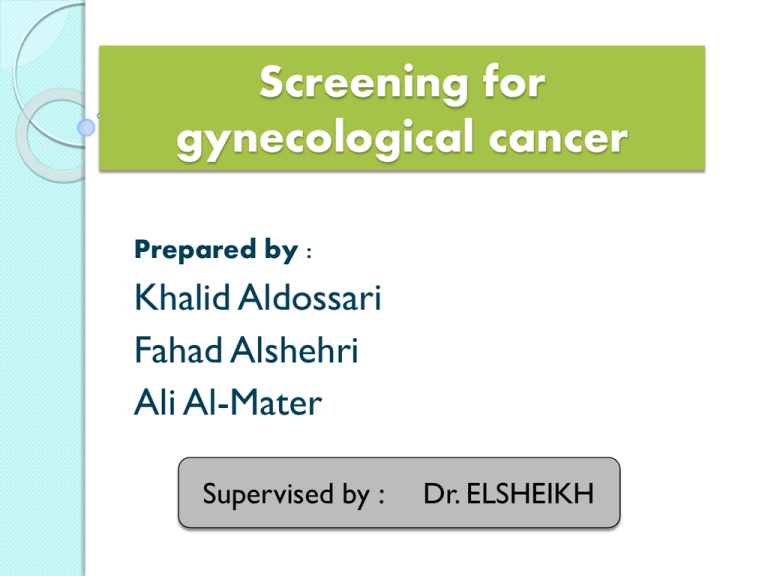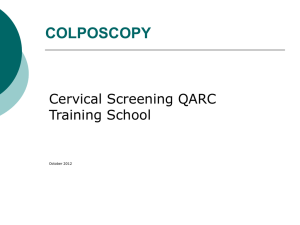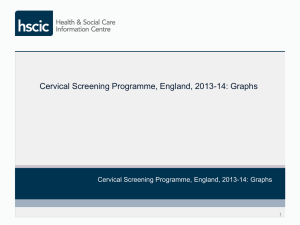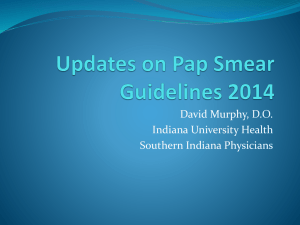
Screening for
gynecological cancer
Prepared by :
Khalid Aldossari
Fahad Alshehri
Ali Al-Mater
Supervised by :
Dr. ELSHEIKH
Out lines :
WHO principles for screening tests .
HPV ( infection , prevention , vaccination )
Cervical precancerous lesions .
Cervical cancer screening ( cytology ,
colposcopy ,histopathology )
Management of Cervical precancerous
lesions ( CIN)
Ovarian and endometrial cancer
screening …. Evidence based results .
Out lines :
HPV ( infection , prevention , vaccination )
Cervical precancerous lesions .
Cervical cancer screening ( cytology ,
colposcopy ,histopathology )
Management of Cervical precancerous
lesions ( CIN)
Ovarian and endometrial cancer
screening …. Evidence based results .
Who principles for screening and
early detection of a disease :
(1) The condition should be an important
health problem.
(2) There should be an accepted treatment for
patients with recognized disease.
(3) Facilities for diagnosis and treatment
should be available.
(4) There should be a recognizable latent or
early symptomatic stage.
Cont ..
(7) The natural history of the condition, including
development from latent to declared disease,
should be adequately understood.
(8) There should be an agreed policy on whom to
treat as patients.
(9) The cost of case-finding (including diagnosis and
treatment of patients diagnosed) should be
economically balanced in relation to possible
expenditure on medical care as a whole.
(10) Case-finding should be a continuing process
and not a "once and for all" project .
The success of screening programs depends on
a number of fundamental principles:
The target disease should be a common form of
cancer, with high associated morbidity or mortality;
Effective treatment, capable of reducing morbidity
and mortality, should be available;
Test procedures should be acceptable, safe, and
relatively inexpensive.
Out lines :
Who principles for screening tests .
Cervical precancerous lesions .
Cervical cancer screening ( cytology ,
colposcopy ,histopathology )
Management of Cervical precancerous
lesions ( CIN)
Ovarian and endometrial cancer
screening …. Evidence based results .
Human Papillomavirus (HPV)
HPV
is the most common sexually
transmitted virus in the United States.
about 75% of sexually active people will
have genital HPV at some time in their
lives.
There
are more than 40 HPV types that
can infect the genital areas of males and
females. These HPV types can also infect
the mouth and throat .
Signs and Symptoms
Most HPV cases are latent infections with no visible
lesions and are only diagnosed by DNA hybridization
testing performed in the evaluation of abnormal pap
smear .
Sub clinical infections have lesions that are only visible
during colposcopy .
Asymptomatic genital HPV infection is common and
usually self-limited.
clinical infections are characterized by readily visible “
warty “ growths called condylomata acuminata on the
vulva , vagina , cervix ,urethra , and perianal area .
condylomata acuminata
Oncogenic, or
high-risk HPV types (e.g.,
HPV types 16 and 18), are the cause of
cervical cancers. These HPV types are
also associated with other anogenital
cancers in men and women, including
penile, vulvar, vaginal, and anal cancer, as
well a subset of oropharyngeal cancers .
Persistent oncogenic HPV infection is the
strongest risk factor for development of
precancers and cancers
Nononcogenic, or low-risk HPV types
(e.g., HPV types 6 and 11), are the cause
of genital warts and recurrent respiratory
papillomatosis ( RRP )
Tests :
HPV tests are available for women aged
>30 years undergoing cervical cancer
screening. These tests should not be used
for men, for women <20 years of age, or
as a general test for STDs. These HPV
tests detect viral nucleic acid (i.e., DNA
or RNA) or protein.
Transmission
Transmission of HPV can occur even when
there are no visible lesions :
1) Direct skin-to-skin contact
2) Sexual activity (Oral, Vaginal & Anal sex)
Regular condom use may provide some
degree of protection .
During pregnancy , condylomata may increase
in number and size , but transmission from
mother to infant is rare .
Diagnosis Of HPV
Abnormal Pap smear
HPV DNA Lab test
Clinical diagnosis of genital warts
Examine infected tissue under a
microscope
Prevention
Two HPV vaccines are
a bivalent vaccine (Cervarix) containing HPV
types 16 and 18 and a quadrivalent vaccine
(Gardasil) vaccine containing HPV types 6,
11, 16, and 18.
Both vaccines offer protection against the
HPV types that cause 70% of cervical
cancers (i.e., types 16 and 18), and the
quadrivalent HPV vaccine also protects
against the types that cause 90% of genital
warts (i.e., types 6 and 11)
Either vaccine can be administered to
girls aged 11–12 years and can be
administered to those as young as 9 years
of age girls .
women ages 13–26 years who have not
started or completed the vaccine series
also should receive the vaccine.
The quadrivalent (Gardasil) HPV vaccine
can also be used in males aged 9–26 years
to prevent genital warts .
Both HPV vaccines are administered as a 3dose series of IM injections over a 6-month
period …( at time 0 ,2 , and 6 months )
For full benefit ,should be administered
before onset of sexual activity( i.e. before
exposure to virus )
Not designed to treat active infections .
Conception should be avoided until 30 days
after last dose of vaccination .
Contraindicated for pregnant women .
Women who have received HPV vaccine
should continue routine cervical cancer
screening because 30% of cervical cancers
are caused by HPV types other than 16
or 18 .
Treatment ;
The reasons for treating genital warts are to
relieve symptoms ( pain and bleeding ) and
to ameliorate psychological and cosmetic
concerns of the pt.
Provider-applied topical therapies include :
1) Podophyllin resin 10% to 25% in tincture of
benzooin
2) Trichloroacetic acid (TCA) or
bichloroacetic acid (BCA) 80% to 90%
Patient applied topical therapies :
1) Podofilox 0.5% solution or gel .
2) Imiquimod 5% cream (acts as an immune response
modifier)
Surgical therapies include
1) Cryotherapy .
2) Surgical excision .
3) Electorocautery .
4) Laser vaporization .
5) Intra lesional interferon
:
.
Notice : Podophyllin , Podofilox, and imiquimod should not
be used during pregnancy .
Out lines :
Who principles for screening tests .
HPV ( infection , prevention , vaccination )
Cervical cancer screening ( cytology ,
colposcopy ,histopathology )
Management of Cervical precancerous
lesions ( CIN)
Ovarian and endometrial cancer
screening …. Evidence based results .
overview
Anatomy:
Endocervix : opening of the cervix into
uterine cavity. It is lined with columnar
epithelium.
Ectocervix: the portion of the cervix that
extends into vagina. It is lined with stratified
squamous epithelium.
The junction between endocervix
(columnar epithelium) and ectocervix
(squamous epithelium) is known as
“Squamo-Columnar Junction”. The position
of SCJ varies throughout the female
reproductive life.
estrogen levels (e.g. puberty, pregnancy)
Moves SCJ towards external
os
Exposing Columnar epithelium to the vaginal
acid environment
Convert to squamous epithelium
Transformation Zone:
The area of metaplastic squamous epithelium
located between the original SCJ and the new
SCJ.
NOTICE : In about 4 % of normal female
infants and about 30% of those exposed to
diethylstilbestrol in utero , the columnar
epithelium extends onto the vaginal fornices .
presentation
Asymptomatic.
Malignancy potential
Progress to be malignant in 8-10 years.
Most lesions will spontaneously regress,
others remain static, with only a minority
progress to cancer.
HPV 16, 18, 31, 33 and 35 are the most
common HPV types associated With
premalignant and cancerous lesions of the
cervix.
Risk Factors
1- HPV infection:
high risk: types 16, 18
(99% of cervical cancers contain one of them)
low risk: types 6, 11.
2- Immunosuppression (HIV infection).
3- STI: trichomonas, HSV.
4-early age of sexual intercourse.
5- multiple sexual partners.
6- smoking.
7- low socioeconomic status.
Benign cervical leesions
i . Nabothian cyst / inclusion cyst
- no treatment is required
ii. Endocervical polyps
- treatment is polypectomy
( office procedure )
Cervical intraepithelial neoplasia
CIN represents a spectrum of disease
ranging from CIN I ( mild dysplasia ) to
CIN III ( severe dysplasia and carcinoma
in situ ) .
At least 35% of patients with CIN III
develop invasive cancer within 10 years ,
whereas lower grades of CIN often
spontaneously regress.
With CIN , there is abnormal epithelial
proliferation above the basement membrane .
Involvement of the inner 1/3 of the epithelium
represents CIN 1
Involvement of the inner ½ to 2/3 represents
CIN II .
Full thickness involvement represents CIN III
with intact basement membrane .
(carcinoma in situ)
The disease is asymptomatic .
Normal
Out lines :
Who principles for screening tests .
HPV ( infection , prevention , vaccination )
Cervical precancerous lesions .
Management of Cervical precancerous
lesions ( CIN)
Ovarian and endometrial cancer
screening …. Evidence based results .
Cervical cancer screening
The aim of modern screening
programmes is mainly the detection of
the non-invasive precursor of the
disease, cervical intra-epithelial neoplasia
(CIN) in the asymptomatic population in
order to reduce mortality and morbidity.
Screening of asymptomatic women
The American College of Obstetricians and
Gynecologists has recommended that all
women undergo an annual physical
examination , including a Pap smear ,
within 3 years of sexual intercourse , or
by age 21 years .
Annual screening should occur until age 30
years .
Cervical screening guidelines (Pap test)
Endocervical and exocervical cell sampling , TZ sampling .
False positives 5-10%
False negatives 10-40% (higher for glandular lesions and for
invasive cancers ) …
- (so, Pap smear identify the patient who has pre-cancerous
lesions and not the one who has invasive cancer. )
Identifies SCC , less reliable for adenocarcinoma .
All women – stat screening at age 21 or 3 years after
onset of vaginal intercourse .
woman > 30 years – if 3 consecutive normal paps, can get
screened every 2-3 years.
When to discontinue?
1- Women older than 70 years, if 3
consecutive normal paps, and NO abnormal
paps in the last 10 years, can discontinue
screening.
2- After total hysterectomy, if performed for
a benign disease.
( subtotal >>> continue screening according
to guidelines )
Exceptions to guidelines :
o Immunocompromised (transplant,
steroids )
o DES exposure
o HIV and high risk
o Unscreened patients .
NOTICE : (Pap smear is not diagnostic ,
for Dx. Tissue biopsy is mandatory).
Classification of an abnormal
Papanicolaou smear :
Bethesda
classification :
For reporting cervical and vaginal cytology .
Epithelial cell abnormalities :
( sequamos and glandular cells )
Squamous cell :
1- Normal:
negative for intra-epithelial lesion or
malignancy.
2- Atypical squamous cells (ASC):
Can be either:
a) ASC-US = Undetermined significance.
b) ASC-H = Can not exclude HSIL.
ASC-US
“borderline”
3- Low-grade squamous epithelial lesion
(LSIL):
biopsy will demonstrate histologic
findings of HPV, mild dysplasia, or CIN I.
4- High-grade Squamous Intra-epithelial
Lesion (HSIL):
Biopsy will demonstrate histologic
findings of moderate dysplasia, severe
dysplasia, CIS, CIN II, or CIN III.
5- sequamous cell carcinoma :
Biopsy will demonstrate histologic
findings of invasive cancer.
If negative for intra epithelial lesions or
malignancy :
Organisms ( e.g. Trichomonas Vaginitis )
Reactive
cellular changes associated with
inflammation ( includes typical repair ) ,
radiation , intrauterine contraceptive device .
Atrophy
.
Bethesda
System
HPV
Type
Morphology
6 ,11
Koilocytic atypia , CIN 1
Flat condyloma
Mild
16 , 18
Progressive
CIN II
cellular atypia ,
&
loss of maturation CIN III
Moderate ,
Severe ,
Low-grad SIL
( L-SIL )
High-grade
SIL (H-SIL)
CIN
Dysplasia
Carcinoma in
Situ .
Glandular cell :
Atypical glandular cells (AGC) ( specify endocervical ,
endometrial ,or not otherwise specified )
Atypical glandular cells , favor neoplastic
( specify endocervical or not otherwise specified ) .
Endocervical adenocarcioma in situ ( AIS ) .
Adenocarcinoma .
Colposcopy
Is inspection of the cervix using a binocular microscope
with a light source.
Indication:
Presence of dysplastic cells or malignant cells on cytology.
An outpatient procedure
An appropriate sized speculum is inserted to expose the
cervix , which is cleaned with a cotton soaked in 3 % acetic
acid to remove adherent mucus and cellular debris .
The original sequamous epithelium appears gray and
homogenous . The columnar epithelium appears red and
grape-like .
The transformation zone can be identified
by the presence of gland openings that
are not covered by the sq. metaplasia and
by the paler color of the metaplastic
epithelium compared with the original
seq.epith .
Nabothian follicles may also be seen in
the transformation zone .
Neoplastic cells appear as a white area with
a well-defined edge following application of
5% acetic acid solution.
Diagnosis is confirmed by taking a biopsy
from the most abnormal-looking areas.
Colposcopy
Colposcopy of the cervix (centre) with CIN 1dysplasia
Figure 12.2 Hlis figure shows
Acetowhite epithelium.
Biopsy and endocervical curettage :
If the colposcopic examination is satisfactory ,
A punch biopsy is taken from the worst area or areas
together with endocervical curettage .
The endocervical curettage is not performed in patients
who are pregnant .
A diagnostic cone biopsy of cervix is indicated in the
following circumstances :
1- Pap smear shows a high grade lesions , and a
colposcopic examination is unsatisfactory .
2- endocervical curettage shows a high-grade lesion.
3- Pap smear shows adenocarcinoma in situ .
4-Microinvasion is present on the punch biopsy .
5 - Pap smear shows high grade lesion that is not
confirmed on punch biopsy .
Out lines :
Who principles for screening tests .
HPV ( infection , prevention , vaccination )
Cervical precancerous lesions .
Cervical cancer screening ( cytology ,
colposcopy ,histopathology )
Ovarian and endometrial cancer
screening …. Evidence based results .
It is reasonable to observe biopsy-proven
CIN I without active treatment because
many cases spontaneously regress .
Active treatment is indicated for CIN II and
CIN III .
Superficial ablative techniques , such as Large
Loop Excision of the Transformation Zone (
LLETZ) , cryotherapy , and carbon dioxide
laser , appropriate if the entire
transformation zone is visible .
LLETZ
Has gained popularity cuz. The equipment
is relatively inexpensive , it can be
performed on an outpatient basis under
local anesthesia , and tissue is obtained
for histological evaluation .
LASER
Destruction of the TZ by carbon dioxide
laser ablation is done as an outpatient
procedure , under local anesthesia .
Bleeding may sometimes occur , but scarring
is minimal , and large lesions may be
destroyed with low failure rates ( 5-10%)
It is expensive , laser has lost favor in most
centers
Cryosurgery :
Relatively painless technique
Outpatient
There is no bleeding
Inexpensive
There is a high failure rate for large lesions and
for lesions extending down glandular crypts .
It is mainly useful for CIN I or II involving 1 or 2
quadrants .
The major side effect is a rather copious vaginal
discharge that persists for several weeks .
Cervical Conization
Mainly a diagnostic technique , but it may be
used for treatment .
Provided that the margins of resection are
clear , cure rates are as high as those with
hysterectomy for intra epithelial lesions
Complications :
1)Bleeding
2)Infection
3)Cervical incompetence .
4) Cervical stenosis .
Hysterectomy
Rarely necessary for the treatment of
CIN .
It may be applicable when there is
concomitant uterine or adnexal disease .
Out lines :
Who principles for screening tests .
HPV ( infection , prevention , vaccination )
Cervical precancerous lesions .
Cervical cancer screening ( cytology ,
colposcopy ,histopathology )
Management of Cervical precancerous
lesions ( CIN)
Ovarian cancer
High
mortality due to late
diagnosis
75% of ca ovary at diagnosis
were at late stage with a 28% 5
yr survival
Stage I ca ovary has 95% 5 yr
survival
Methods used for ovarian cancer
screening
Serum
CA125
Transvaginal ultra sonogram
Multimodal
New method under
investigation lysophosphatidic acid
Serum CA125
Elevated
in 82% of ovarian
cancer and <1% of healthy
women
rising pattern over time
preceded ovarian cancer
limitations: lack of sensitivity in
Stage I disease, poor specificity
(elevated in benign and other
malignant conditions)
Screening
Not feasible because US and available
tumor markers for example CA 125 , lack
specificity and sensitivity for early-stage
disease .
Carcinoma of Endometrium
Incidence : third commonest
malignant tumors
of genital tract .
Age
: 58
Risk factors
nulliparity, anovulation, late
menopause
exogenous estrogen
endogenous estrogen
DM, HT, obesity
smoking, white
tamoxifen
familial history
Postmenopausal Bleeding
1) carcinoma of endometrium
2) other gynecological malignancy
3) atrophic endometritis
4) endometrial hyperplasia
5) cervicitis/erosion
6) endometrial polyp
7) cervical polyp
14%
14%
20%
12%
8%
8%
8%
Endometrial Cancer Screening
Tools
explored
◦ pelvic ultrasound (>8mm
endometrial thickness in
postmenopausal women) Karlsson
1995
◦ endometrial aspirate (inadequate
sampling in menopausal women)
Endometrial aspirator
Endometrial aspirator
Endometrial aspiration
Sensitivity
for endometrial ca
94% in patient with symptoms
sensitivity for hyperplasia 31%
Cons: discomfort to patient
lack of known efficiency in
asymptomatic patients
TVS in endometrial ca screening
Croatia
study (Kurjak 1994)
5013 asymptomatic women
ca endometrium 6 and
hyperplasia 18, no false positive
(low prevalence of ca
endometrium in asymptomatic
patients, ?
THE END






